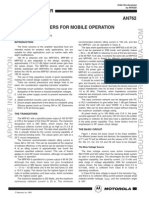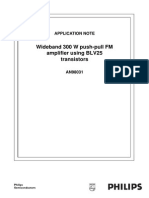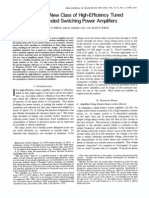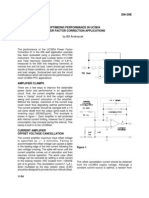Simple Class A Amplifier by JL Linsley Hood Wireless World Dec 1970 Jlh1970
Simple Class A Amplifier by JL Linsley Hood Wireless World Dec 1970 Jlh1970
Uploaded by
sandrocalCopyright:
Available Formats
Simple Class A Amplifier by JL Linsley Hood Wireless World Dec 1970 Jlh1970
Simple Class A Amplifier by JL Linsley Hood Wireless World Dec 1970 Jlh1970
Uploaded by
sandrocalOriginal Description:
Original Title
Copyright
Available Formats
Share this document
Did you find this document useful?
Is this content inappropriate?
Copyright:
Available Formats
Simple Class A Amplifier by JL Linsley Hood Wireless World Dec 1970 Jlh1970
Simple Class A Amplifier by JL Linsley Hood Wireless World Dec 1970 Jlh1970
Uploaded by
sandrocalCopyright:
Available Formats
Wireless World, December 1970
Simple Class A Amplifier
A postscript to the design published last year
by J. L. Linsley Hood
The author has had the benefit of an extensive and frequently helpful correspondence with readers
following the publication of the circuit design. Attention has been drawn to some obscurities in the
original article and to certain possible improvements in the design. Details are given below.
Power supply
Although much interest was aroused among constructors by the good technical (and audible)
performance given by the amplifier, it is clear that the principal feature in the eyes of many users was the
relative simplicity of the circuit. This being so it must have seemed a pity that the power-supply unit was
somewhat complex. However, the purpose of this power-supply design was to avoid possible
degradation of the amplifier performance by h.t. ripple. The sawtooth ripple voltage across the reservoir
capacitor in a class-A amplifier drawing some 2-3A will be many times greater than in a class-B system,
particularly at the audibly important low-signal levels.
However, a number of measurements have been made since the publication of the original article on an
amplifier of this type, operated from a simple supply unit of the type shown in Fig. 1. There is little
difference in the performance above 100Hz either in total harmonic distortion or in intermodulation
distortion, although the shape of the output power/distortion curve at the onset of overload is modified,
as would be expected, by the ripple on the h.t. line. Below 100Hz the distortion curve rises more steeply
to about 0.2% at 20Hz.
A thermister is necessary, in this case, to slow down the rate of rise of the h.t. voltage. This will get hot in
use.
It now appears that the mains transformers used in the development of the prototype of this amplifier
were not as efficient in respect of apparent secondary circuit resistance or secondary leakage reactance
as some of those which have been supplied for this purpose since the publication of the article. The
reservoir voltage found with the 15 system may be above that given by the author. At switch-on this
can cause a transient overloading of the transistors specified for the series regulator circuit in the original
article. In view of this, it is suggested that these should be an MJ481 or 2N3055, used in conjunction with
a 2N1613 or, better still, a 2N699. These amendments are shown in Fig. 2.
Adjustment of amplifier output current and centre-line potential
The author had supposed, somewhat naively, that most constructors of the circuit would have
somewhere in their workshops a collection of odd-value resistors needed for trimming circuit parameters,
and it was mentioned in the original article that the desired quiescent levels could be set by adjustment
to R2 and R5 or R6. This sort of comment is unhelpful if one is writing away for a kit of parts. In view of
this it is suggested that R2 should be replaced by a resistor in series with a potentiometer, as shown in
Fig.1. The necessary value of resistors R5 and R6 to give an entirely adequate accuracy in the mid-point
voltage setting can be predicted, and the suggested amended values are shown.
Some obscurity arose, inadvertently, in the original diagram concerning the reason for the different
values of input decoupling resistor quoted for mono and stereo use. This was because it was intended
that the one decoupling circuit should serve both channels. Where an unsmoothed h.t. supply is used it
is recommended that the decoupling capacitor should be increased in value to 250F.
Page 1 of 4
Wireless World, December 1970
Stability of output current setting
Some criticism has been voiced because there is no specific control over the output current value in the
simplest form of this circuit, other than that due to the stability of the current gain of Tr2, whose
performance determines this parameter. In order to meet this point (in anticipation) a circuit was
described in the original article which allowed precise control over the operating quiescent current
without detriment to the performance of the amplifier.
However, measurements made on an amplifier without this addition have shown no significant change in
operating current in somewhat over two years use, and there is also little measurable difference in
current from a minute or so after switch-on to the end of a six-hour period of continuous use. In practice
therefore, in temperate climates at least, the simplest form of the circuit is adequate in this respect. If any
user cares to experiment with an alternative and somewhat more elegant form of quiescent-current
control another regulation circuit is shown in Fig. 3. The transistor used as Tr5 requires to be somewhat
more massive than that used for Tr3 since the mean collector current is twice that of Tr3 and the
maximum voltage and current occur simultaneously. The 2N2905A is just about adequate with a good
heatsink, but a larger power device such as the 2N4919 is preferable.
Alternative transistor types
The amplifier has been built successfully with a wide variety of transistors, including fully complementary
versions to operate from an existing negative h.t. line, and in one case two identical amplifiers have been
made for use with the inputs in paraphase, in order to double the available output voltage swing. One
constructor has, indeed, made a stereo 30W system using two such pairs of amplifiers plus input phase
splitter, as shown in Fig. 4.
However, one transistor change which is recommended is the use of a 2N1711 as Tr3. This has a high
voltage capability equal to that of the 2N1613, and a current gain which is double that of either the
2N1613 or the 2N697. The use of the 2N1711 instead of the former types suggested for Tr3 increases
the feedback factor and approximately halves the typical distortion factor of the system (0.025% at 9W or
0.05% at full power) without detriment in other respects.
Also, a 2N1711 as Tr3 allows the use of 2N3055 devices as Tr1 and Tr2, with a final performance which
is equal to that of the original specification below 100kHz. (The typical current gain of the 2N3055s is
only half that normally found with the MJ480/1 output transistors, and their use was not originally
recommended for this reason.)
Gain/frequency and power/frequency characteristics
These are, in fact, better than the curves published in April 1969. As mentioned in a letter to the editor
published in October 1969, the h.f. fall-off shown was mainly due to an error in the measurement
instrument. Although the performance at h.f. depends to some extent on the layout employed, the small
signal voltage gain, with the component arrangement shown, is flat (within 1dB) to beyond 2MHz. This
may be a snag in some cases because even a small feedback capacitance between output and input (as
may happen, for example, if the output heatsinks are not earthed) may cause the amplifier to oscillate. A
suitable circuit change to reduce the amplifier h.f. response to more normal levels was described in the
letter above. This is not an essential modification the authors own units are still exactly as described in
April 1969.
The output power response of the unmodified amplifier is flat within 1dB to 200kHz.
The l.f. response shown in the original gain/frequency and power/frequency graphs was that determined
for an earlier prototype of the amplifier. During the development of the circuit the values of some of the
capacitors were increased to improve the l.f. performance, and by an oversight the graphs
accompanying the article were not amended. In fact the gain and power graphs can be shown as flat
from 10Hz-200kHz. In this respect, and that of transient response, the class-A design is probably better
than any circuit so far published. The i.m. distortion, at 10W output, (70Hz and 7kHZ, 4:1) is less than
0.1%.
Page 2 of 4
Wireless World, December 1970
Miscellaneous
Surprise and even alarm has been caused to some constructors by the fact that the output
transistors get hot. However, with adequate heatsinks, which should be black painted, the dissipations in
the transistors are only a small fraction of the makers permitted level, and provided that some care is
taken in the layout to make sure that sensitive components, such as electrolytic capacitors, remain cool,
no reduction in the working life of such a system, in comparison with an equivalent class-B unit for
example, is to be expected.
Some difficulty has apparently been encountered by some constructors because the power supply
regulation system is inoperative when the supply is operated without a load. If an equivalent resistive
dummy load is connected for bench-testing, all should be found to be well.
Finally, it is prudent to wire a small resistor of about 2k across the loudspeaker terminals to make sure
that the output capacitor charges even with the speaker disconnected. Charging of the capacitor by an
accidental short-circuit could cause damage. This addition is shown in Fig. 1. No damage is caused by
operating the amplifier on an o / c output.
Figures
Fig. 1. Suggested amended circuit for 8 or 15 use employing a simplified power supply.
The dotted components reduce the h.f. response and should be used with capacitive loads.
Page 3 of 4
Wireless World, December 1970
Fig. 2. Amended circuit of power supply for 15
systems.
Fig. 3. Alternative method of quiescent-current control. R1, R2 and C1 in the
original have been deleted. Tr5 is 2N4919 on heatsink or alternative type.
Fig. 4. Scheme for 30W class-A system. The two identical class-A amplifiers, each designed to
give 15W into 8 (34V at 1.5A), are driven by a phase-splitter. The output capacitors have been
removed.
Page 4 of 4
You might also like
- Power and Speed Trade-Offs in Data Path Structures Array SubsystemsDocument54 pagesPower and Speed Trade-Offs in Data Path Structures Array Subsystemssivaeinfo100% (1)
- Siemens Oem Data Sheet - sv150 - 30 - 50c 100 04200028 PDFDocument4 pagesSiemens Oem Data Sheet - sv150 - 30 - 50c 100 04200028 PDFاحمد زغارىNo ratings yet
- Lte Sa & So AlarmsDocument6 pagesLte Sa & So AlarmsMuthulingamNo ratings yet
- A 300W MOSFET Linear Amplifier For 50 MHZ APT9802Document8 pagesA 300W MOSFET Linear Amplifier For 50 MHZ APT9802Gabriel DediuNo ratings yet
- Linsley Hood Class A PDFDocument17 pagesLinsley Hood Class A PDFMastroghettiNo ratings yet
- Classd A Mj480Document9 pagesClassd A Mj480bladybochoNo ratings yet
- Linsley Hood Class PDFDocument129 pagesLinsley Hood Class PDFBenedekEduardNo ratings yet
- Opamp Linear Device 1300847494 PDFDocument12 pagesOpamp Linear Device 1300847494 PDFNini FarribasNo ratings yet
- Motorola AN758Document16 pagesMotorola AN758xavir111No ratings yet
- NJ 10 WDocument14 pagesNJ 10 WmuszereszNo ratings yet
- El Amplificador OperacionalDocument24 pagesEl Amplificador OperacionalSteve ResidenceNo ratings yet
- Flyback Power Supply Development - Part IIIDocument4 pagesFlyback Power Supply Development - Part IIIMuhammad Saqib AliNo ratings yet
- 20W HF PA Construction V2-1Document9 pages20W HF PA Construction V2-1diligore2399No ratings yet
- Design of A Class F Power Amplifier: Piers O V NDocument4 pagesDesign of A Class F Power Amplifier: Piers O V NstepannpNo ratings yet
- Class D Com FonteDocument29 pagesClass D Com FontenicchioNo ratings yet
- Linear Amps For Mobile OperationDocument10 pagesLinear Amps For Mobile OperationIan McNairNo ratings yet
- OTA Structures2Document13 pagesOTA Structures2Debopam DattaNo ratings yet
- A Comparator With Reduced Delay Time in 65-nm CMOS For Supply Voltages Down To 0.65 VDocument5 pagesA Comparator With Reduced Delay Time in 65-nm CMOS For Supply Voltages Down To 0.65 VSrinivasAnchalaNo ratings yet
- UnilabDocument5 pagesUnilabshoker4No ratings yet
- P M D-A A: Martin Pospisilik, Jiri Kasacek, Michaela Mikulicova, Milan AdamekDocument6 pagesP M D-A A: Martin Pospisilik, Jiri Kasacek, Michaela Mikulicova, Milan Adamekisauro yardani altamiranda martinezNo ratings yet
- SZZN 001Document7 pagesSZZN 001hatemNo ratings yet
- Build A Class-A AmplifierDocument9 pagesBuild A Class-A AmplifierFe DnyNo ratings yet
- A Buck-or-Boost Converter Module With Embedded Inductor and Fast Current LimitDocument10 pagesA Buck-or-Boost Converter Module With Embedded Inductor and Fast Current LimitVeeraiah BodduNo ratings yet
- Class C AmplifierDocument14 pagesClass C AmplifierSuresh Kumar SubbiahNo ratings yet
- Power Supply Design Basics: Figure 3: Full Wave Rectified Output From TheDocument6 pagesPower Supply Design Basics: Figure 3: Full Wave Rectified Output From Theprotesto06No ratings yet
- 300 WattsDocument31 pages300 WattsJosue PazNo ratings yet
- 1707 An253 Power Supply Design Basics ImpDocument6 pages1707 An253 Power Supply Design Basics ImpbmmostefaNo ratings yet
- Exercise On Analog Circuits: PHYS 331: Junior Physics Laboratory IDocument6 pagesExercise On Analog Circuits: PHYS 331: Junior Physics Laboratory Iviso167No ratings yet
- IGBT Module For Advanced NPC Topology: Kosuke Komatsu Takahito Harada Haruo NakazawaDocument6 pagesIGBT Module For Advanced NPC Topology: Kosuke Komatsu Takahito Harada Haruo NakazawaVijai MoganNo ratings yet
- Single Stage PFCconverterDocument10 pagesSingle Stage PFCconvertersquall8712No ratings yet
- 15Document11 pages15dr_best_001No ratings yet
- Field-Effect Transistors and Transistor AmplifiersDocument6 pagesField-Effect Transistors and Transistor Amplifierssuper_lativoNo ratings yet
- SmpsDocument16 pagesSmpsAkhila Reghuchandren ANo ratings yet
- 100 and 200 Watt High Fidelity Audio Amplifiers Utilizing A Widebandćlow Feedback Design An1308Document24 pages100 and 200 Watt High Fidelity Audio Amplifiers Utilizing A Widebandćlow Feedback Design An1308alvarodellanaveNo ratings yet
- Motorola High Fidelity Amplifer 200WDocument24 pagesMotorola High Fidelity Amplifer 200Wregelemar100% (2)
- Web Anywhererr PDFDocument9 pagesWeb Anywhererr PDFJeena MathewNo ratings yet
- 150 Watt Single Bander 1957Document8 pages150 Watt Single Bander 1957Domingos SanchezNo ratings yet
- Zulu James Lab 1 4157Document7 pagesZulu James Lab 1 4157James Jimmy JahNo ratings yet
- Modern DC To DC Switchmode Power Converter CircuitsDocument362 pagesModern DC To DC Switchmode Power Converter CircuitsTocean Duong100% (5)
- Islanding of Grid-Connected PV Inverters: Test Circuits and Some Test ResultsDocument4 pagesIslanding of Grid-Connected PV Inverters: Test Circuits and Some Test ResultsSanjay DevrajNo ratings yet
- Bhwna Unit 5Document9 pagesBhwna Unit 5Pradeep KumarNo ratings yet
- Recetario TransistoresDocument23 pagesRecetario TransistoresTitán SotoNo ratings yet
- Sokal & Sokal, Class E, IEEE JSSC Jun'75 p168-176Document9 pagesSokal & Sokal, Class E, IEEE JSSC Jun'75 p168-176jrmciNo ratings yet
- 15-20W Class AB Audio Amplifier: A Design With Class-A Performance But Reduced Thermal DissipationDocument10 pages15-20W Class AB Audio Amplifier: A Design With Class-A Performance But Reduced Thermal DissipationDaniel ScardiniNo ratings yet
- Two-Level and Three-Level Converter Comparison in Wind Power ApplicationDocument11 pagesTwo-Level and Three-Level Converter Comparison in Wind Power ApplicationIkram RidhoNo ratings yet
- A New High-Efficiency Single-Phase Transformerless PV Inverter TopologyDocument8 pagesA New High-Efficiency Single-Phase Transformerless PV Inverter TopologyMohamed SaidNo ratings yet
- An 1198Document12 pagesAn 1198Orozco LoraineNo ratings yet
- 1.1 Introduction To Buck ConverterDocument44 pages1.1 Introduction To Buck Converterapi-19810277No ratings yet
- Design Note: Optimizing Performance in Uc3854 Power Factor Correction ApplicationsDocument42 pagesDesign Note: Optimizing Performance in Uc3854 Power Factor Correction ApplicationsidsufixNo ratings yet
- Interleaved Boost Converter With Intrinsic Voltage-Doubler Characteristic For Universal-Line PFC Front EndDocument8 pagesInterleaved Boost Converter With Intrinsic Voltage-Doubler Characteristic For Universal-Line PFC Front EndHema LathaNo ratings yet
- Development of New AC To DC Converters For EHVDocument5 pagesDevelopment of New AC To DC Converters For EHVMouliNo ratings yet
- A New Single-Phase Single-Stage Three-Level Power Factor Correction AC-DC ConverterDocument12 pagesA New Single-Phase Single-Stage Three-Level Power Factor Correction AC-DC Convertersurya_v988No ratings yet
- A Unity Power Factor Converter Using HalfDocument14 pagesA Unity Power Factor Converter Using HalfLivia Faria PeresNo ratings yet
- 250 W S.M.P.S. With Power-FETs James ArthurDocument12 pages250 W S.M.P.S. With Power-FETs James Arthurniku_No ratings yet
- Widlar Bandgap PaperDocument6 pagesWidlar Bandgap PapercrglstNo ratings yet
- 3-Phase PFC KolarDocument7 pages3-Phase PFC KolarJayant SalianNo ratings yet
- w5bwc Rs35 RebuildDocument12 pagesw5bwc Rs35 RebuildLaurentiu IacobNo ratings yet
- AN282 Systemizing RF Power Amplifier DesignDocument6 pagesAN282 Systemizing RF Power Amplifier DesignfahkingmoronNo ratings yet
- 2m Hpa ManualDocument7 pages2m Hpa Manualmariusnaicuyahoo.comNo ratings yet
- Reference Guide To Useful Electronic Circuits And Circuit Design Techniques - Part 2From EverandReference Guide To Useful Electronic Circuits And Circuit Design Techniques - Part 2No ratings yet
- Reference Guide To Useful Electronic Circuits And Circuit Design Techniques - Part 1From EverandReference Guide To Useful Electronic Circuits And Circuit Design Techniques - Part 1Rating: 2.5 out of 5 stars2.5/5 (3)
- 1024K NV SRAM With Phantom Clock: DS1248/DS1248PDocument19 pages1024K NV SRAM With Phantom Clock: DS1248/DS1248Pjoao victorNo ratings yet
- Cisco Catalyst 9115 Series Wi-Fi 6 Access Points: Data SheetDocument33 pagesCisco Catalyst 9115 Series Wi-Fi 6 Access Points: Data Sheetbonsai todayNo ratings yet
- BEC402 - POCS - Assignment 1Document1 pageBEC402 - POCS - Assignment 1jbNo ratings yet
- Std11 CompSci EMDocument392 pagesStd11 CompSci EMnatarajNo ratings yet
- Bug Report 21Document5 pagesBug Report 21Amanda Cristina BenícioNo ratings yet
- Design A Dual-Band Microstrip Antenna For Wireless (GPS) ApplicationDocument3 pagesDesign A Dual-Band Microstrip Antenna For Wireless (GPS) ApplicationSweatha Manju KNo ratings yet
- Electronic Workbench PracticlesDocument23 pagesElectronic Workbench Practiclesapi-394738731No ratings yet
- VX3211-2K-mhd Display: User GuideDocument57 pagesVX3211-2K-mhd Display: User GuideArtNo ratings yet
- Charcterisation of Acoustic in Open Offfice 4 Case StudyDocument6 pagesCharcterisation of Acoustic in Open Offfice 4 Case StudyMohd Zulhairi Mohd NoorNo ratings yet
- AIWA MANUAL de SERVIÇO DVD SISTEM HT-DV90 JANDUIDocument68 pagesAIWA MANUAL de SERVIÇO DVD SISTEM HT-DV90 JANDUIcarrodz65No ratings yet
- Final - Rotary Pre-CommissioningDocument3 pagesFinal - Rotary Pre-CommissioningLENINROMEROH4168No ratings yet
- Quick Start Manual: - Cable Diagrams: 2 Wire RS485 Cable Connections: Plcsideor /etwork Side 2 MeterDocument1 pageQuick Start Manual: - Cable Diagrams: 2 Wire RS485 Cable Connections: Plcsideor /etwork Side 2 MeterJhon SierraNo ratings yet
- Ycjd 18-60 Partes 035-22018-001-F-0610Document4 pagesYcjd 18-60 Partes 035-22018-001-F-0610Jacinto Romero Tellez100% (1)
- DLD Lab 2Document4 pagesDLD Lab 2گيدوڙو ماڇيNo ratings yet
- Resistance Thermometer - WikipediaDocument1 pageResistance Thermometer - WikipediaMuhammad AwaisNo ratings yet
- How To Re-Condition A Dead Car BatteryDocument3 pagesHow To Re-Condition A Dead Car BatteryDonnieDukesNo ratings yet
- Speed Regulation in Induction MotorDocument1 pageSpeed Regulation in Induction MotornellaiNo ratings yet
- Physics Investigatory ProjectDocument18 pagesPhysics Investigatory ProjectPravesh KumarNo ratings yet
- B4Vienna2023-1143-Mitra-Simulations and Field Experience of Opladen STATCOM With Grid-Forming Behavior ADocument9 pagesB4Vienna2023-1143-Mitra-Simulations and Field Experience of Opladen STATCOM With Grid-Forming Behavior Ajaek709No ratings yet
- Trends in Electric Vehicle Propulsion TechnologyDocument28 pagesTrends in Electric Vehicle Propulsion TechnologyAlex Kariyil50% (2)
- 057-085 9xx 91xx 92xx 94xx Ops PDFDocument74 pages057-085 9xx 91xx 92xx 94xx Ops PDFDorivaldo NogueiraNo ratings yet
- TDS For Open Street Light Drivers-SVLDDocument16 pagesTDS For Open Street Light Drivers-SVLDFM OperationNo ratings yet
- Usurface IIIDocument2 pagesUsurface IIIjanurNo ratings yet
- SymbolsDocument8 pagesSymbolsgaganesan1972No ratings yet
- Telecomandojolly2-24 InstrDocument64 pagesTelecomandojolly2-24 InstrRiccardo MaremmaladraNo ratings yet
- General Description Product Summary: 100V N-Channel AlphamosDocument6 pagesGeneral Description Product Summary: 100V N-Channel AlphamosRoby CottoNo ratings yet
- LPT40 Series: 40 WattsDocument5 pagesLPT40 Series: 40 WattsFABIAN FIGUEROANo ratings yet

























































































